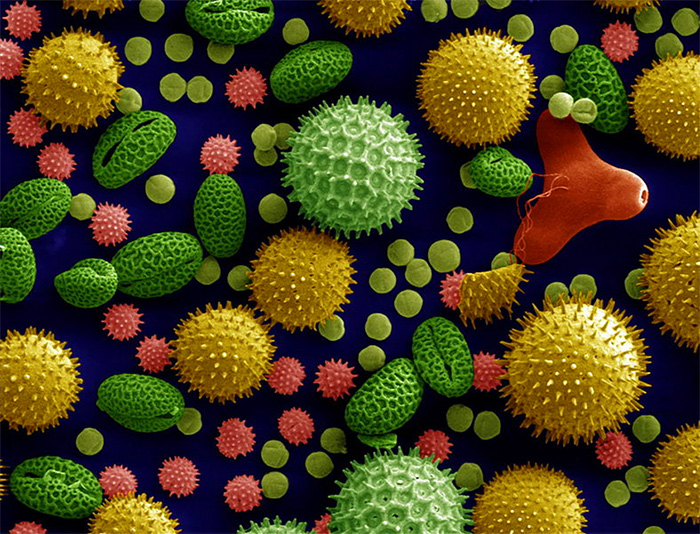
Grains of pollen are like Mother Nature’s fingerprints, allowing scientists to track the migratory paths of dinosaurs and solve long-cold murder cases.
Flowering plants evolved 100 million years ago, and within 30 million years dominated the planet. Today, there are almost 400,000 species.
One reason for their global success is their remarkable fertilization system.
A single flower can produce hundreds of thousands of pollen grains, which can be distributed by the wind, insects, or animals, fertilizing other plants miles away.
Each plant produces a distinct-looking pollen grain. And each place on Earth, even each square block or backyard garden, has a distinct mix of plants.
By studying the mix of pollen grains found on a person, animal, or object, scientists can now tell precisely where they have been.
And since pollen is highly durable, outlasting the plants that produced it by thousands of years and surviving in the fossil record for millions, scientists can use it for ancient detective work.
Recently, paleontologists used fossil pollen in the digestive tracts of dinosaurs to tell what they ate and where.
Forensic palynologists now use pollen found on murder victims and suspects to place them in the same location, or even to discover where bodies have been hidden.
The new science of palynology is cross-pollinating many other fields, allowing a deeper understanding of Earth.
Background
Synopsis: Pollen, which has been around since dinosaurs roamed Earth, can answer a surprising number of questions about the geologic past as well as modern crime scenes.
- Earth today has more than 380,000 species of flowering plants.
- Mosses were the first land plants, evolving about 425 million years ago in the Silurian period. Mosses produce spores, which may be preserved in rocks.
- It took 300 million more years before the first flowering plants, or angiosperms, evolved 140–125 million years ago, in the age of dinosaurs. Within 30 million years, angiosperms spread across the planet to dominate the land.
- Their spectacular success may be attributed to their incredibly resilient reproductive process; their tiny grains of pollen and seeds help to propagate their species far from the original location of the parent plant.
- Each anther on the top of a single stamen of a flower may produce more than 100,000 grains of pollen. Some pollen grains are smooth and typically blown by the wind. Some are spiky, with tiny barbs designed to stick to insects and disperse as insects fly from plant to plant.
- Different ecological zones have specific groupings of plants that generate predictable pollen assemblages, with different percentages of specific pollen types that can vary even between next-door gardens.
- Because different pollen assemblages occur in different seasons, timing of the pollen sample within the year can often be determined.
- Many species of plants have gone extinct, but fossil pollen can be used to infer the age of insect or animal fossils and sediments they are buried in, as well as to decipher the activities of ancient humans.
- Geologic detectives called paleontologists use fossil pollen from fossilized dinosaur and mammal digestive tracts to figure out what kind of plants prehistoric animals ate and how far they might have migrated.
- Anthropologists use fossil pollen to illustrate the impact of climate variations on human cultures.
- The Bonfire Shelter is an archaeological site in southwest Texas where ancient bison hunters stampeded herds over cliffs, then butchered them. Two distinct zones of bones are preserved, each with a span of 50–100 years of use—but they are separated by 7,500 years of time! Palynologists figured out that in the past 10,000 years, the area had only seen two periods when climate was favorable enough for grasses to support large herds of bison; these times of plenty correlated with the zones of bones.
- The last days of Ötzi the Iceman have been chronicled by teams including palynologists who used pollen found in his stomach to determine the season when he died (spring or early summer), as well as the route he walked over the last 2 days of his life. (More on Ötzi in a future EarthDate episode!)
- Forensic palynologists study modern crime scenes using pollen. With nearly 400,000 types of modern pollen and millions more types of fossil pollen that could show up even on modern crime scenes, the task of identification can be very difficult.
- In addition to angiosperm pollen, millions of different types of spores from other plants like mosses and ferns can help to narrow down specific settings.
- Pollen from specific unique plants brushed onto clothing has been used to prove that a suspect was in a particular garden location.
- Pollen has been used to track counterfeit money and drug-drop locations.
- Pollen has been proposed as an additive to bullets to enable tracking them.
- In Bosnia, pollen was used to trace the original burial sites of bodies that had been exhumed and moved to mass graves.
- Governments have tried to automate visual analysis of pollen without success. Recently, using DNA barcoding of pollen along with traditional methods has proven to be a practical way of speeding up the painstaking analysis and making it even more mainstream.

